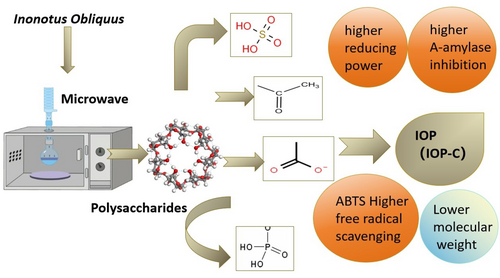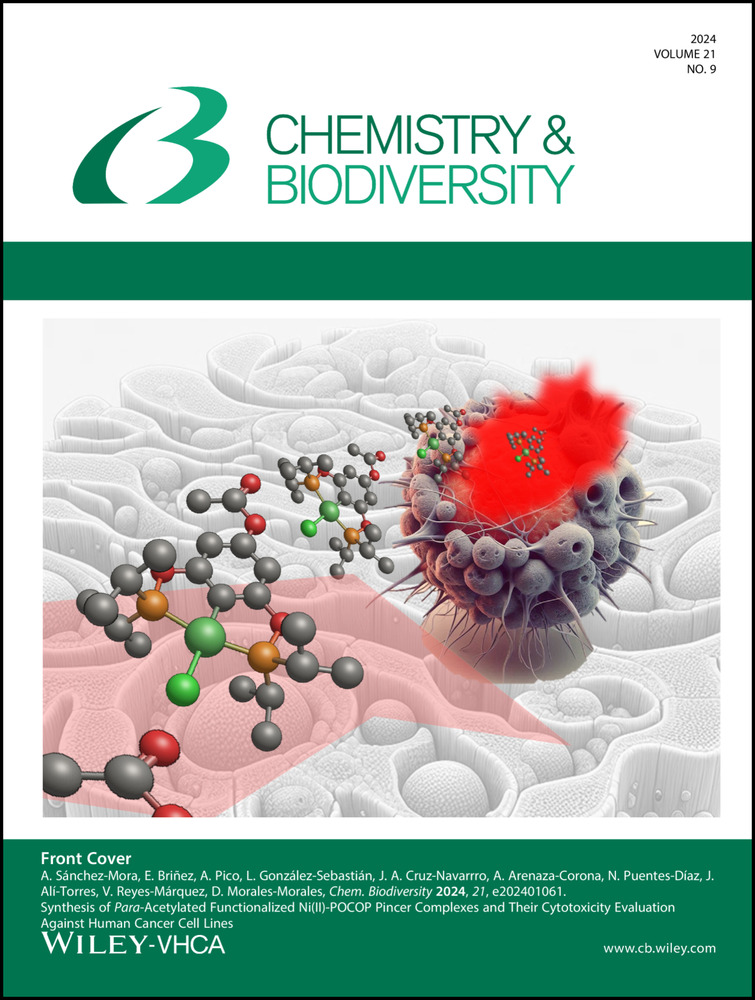Effects of Chemical Modification on the Structure and Biological Activities of Polysaccharides Extracted from Inonotus Obliquus by Microwave
Hao Xie
College of Biological Science and Technology, Yili Normal University, Yining, 835000 China
These authors contributed equally to this work and are co-first authors
Search for more papers by this authorWenwen Li
College of Biological Science and Technology, Yili Normal University, Yining, 835000 China
These authors contributed equally to this work and are co-first authors
Search for more papers by this authorLinghe Zhang
College of Biological Science and Technology, Yili Normal University, Yining, 835000 China
Search for more papers by this authorCorresponding Author
Nurmamat Eliyas
College of Biological Science and Technology, Yili Normal University, Yining, 835000 China
Search for more papers by this authorHao Xie
College of Biological Science and Technology, Yili Normal University, Yining, 835000 China
These authors contributed equally to this work and are co-first authors
Search for more papers by this authorWenwen Li
College of Biological Science and Technology, Yili Normal University, Yining, 835000 China
These authors contributed equally to this work and are co-first authors
Search for more papers by this authorLinghe Zhang
College of Biological Science and Technology, Yili Normal University, Yining, 835000 China
Search for more papers by this authorCorresponding Author
Nurmamat Eliyas
College of Biological Science and Technology, Yili Normal University, Yining, 835000 China
Search for more papers by this authorAbstract
A novel polysaccharide, Inonotus obliquus polysaccharide (IOP), was extracted using a microwave extraction method and subsequently subjected to modifications through sulfation, carboxymethylation, phosphorylation, and acetylation. Its physical and chemical properties were analyzed using various chemical techniques, including high-pressure liquid chromatography, ultraviolet light, Fourier-transform infrared spectroscopy, X-ray diffraction, Congo red test, and scanning electron microscopy. The antioxidant capacity was assessed using DPPH, ABTS, and hydroxyl radical assays, as well as by measuring the reducing power. Additionally, hypoglycemic activity was evaluated through α-glucosidase and α-amylase assays. The results indicated that the chemical modifications effectively altered the physical and chemical properties, as well as the biological activities of IOP. Compared to the unmodified IOP, the derivatives exhibited reduced sugar content, uronic acid content, and molecular weight, while demonstrating varying levels of antioxidant and hypoglycemic capabilities. Notably, the carboxymethylated IOP (IOP−C) displayed lower molecular weight, higher ABTS free radical scavenging rate, greater reducing ability, and increased α-amylase inhibition rate. Therefore, IOP−C shows promise as a potential edible antioxidant and hypoglycemic agent.
Graphical Abstract
Conflict of Interests
The authors declare no conflict of interest.
Open Research
Data Availability Statement
The data that support the findings of this study are available from the corresponding author upon reasonable request.
References
- 1G. Anwaier, C. Wen, Y. N. Cao, R. Qi, Mini-Rev Org Chem 2021, 18, 529–538.
- 2
- 2aY. Lu, Y. Jia, Z. Xue, N. Li, J. Liu, H. Chen, Polymers (Basel) 2021, 13;
- 2bL. Ma, H. Chen, Y. Zhang, N. Zhang, L. Fu, Carbohydr Polym 2012, 89, 371–378.
- 3C. J. Zhang, J. Y. Guo, H. Cheng, L. Li, Y. Liu, Y. Shi, J. Xu, H. T. Yu, Int J Biol Macromol 2020, 151, 855–860.
- 4N. Zhang, H. Chen, L. Ma, Y. Zhang, Int J Biol Macromol 2013, 54, 209–215.
- 5G. Beltrame, J. Trygg, J. Hemming, Z. Han, B. Yang, J Fungi (Basel) 2021, 7.
- 6S. Li, Q. Xiong, X. Lai, X. Li, M. Wan, J. Zhang, Y. Yan, M. Cao, L. Lu, J. Guan, D. Zhang, Y. Lin, Compr Rev Food Sci Food Saf 2016, 15, 237–250.
- 7F. Wang, Z. G. Chen, H. J. Zhu, Biochem Eng J 2013, 79, 25–28.
- 8B. Wang, L. Yan, S. Guo, L. Wen, M. Yu, L. Feng, X. Jia, Front Nutr 2022, 9, 908175.
- 9L. Yuyang, P. Jiaju, J. Peiyi, L. Yingtao, M. Xiaoman, L. I. Ping-fan, F. Huajun, Food Chem 2022.
- 10A. Abuduwaili, P. Rozi, P. Mutailifu, Y. H. Gao, R. Nuerxiati, H. A. Aisa, A. Yili, Proc Biochem 2019, 83, 189–197.
- 11F. Zhou, S. Yan, S. Chen, L. Gong, T. Su, Z. Wang, Pharmacogn Mag 2016, 12, S277–284.
- 12Q. Wei, Y. H. Zhang, Ultrason Sonochem 2023, 96, 106422.
- 13Y. T. Wu, Y. F. Huo, L. Xu, Y. Y. Xu, X. L. Wang, T. Zhou, Int J Biol Macromol 2020, 165, 2116–2125.
- 14L. Chen, G. Huang, Int J Biol Macromol 2019, 125, 256–261.
- 15R. Tian, Y. Z. Zhang, X. Cheng, B. Xu, H. Wu, Z. Q. Liang, M. Rahman, Y. Wang, N. K. Zeng, Int J Biol Macromol 2023, 253, 127200.
- 16N. Wang, Z. Chen, J. Lv, T. Li, H. Wu, J. Wu, H. Wu, W. Xiang, Ind Crop Prod 2023, 191, 115936–115936.
- 17D. J. Wexler, JAMA 2019, 322, 1147–1149.
- 18H. Xue, Z. Hao, Y. Gao, X. Cai, J. Tang, X. Liao, J. Tan, Int J Biol Macromol 2023, 252, 126199.
- 19Y. Fan, G. Huang, Chem Biodivers 2023, 20, e202201253.
- 20L. Xiaoli, T. Xiao-Fang, T. Kiran, Z. Ying-Shuo, Z. Dan-Ye, Z. Jianguo, W. Zhao-Jun, Int J Biol Macromol 2018, 112, 675–685.
- 21R. Nuerxiati, P. Mutailipu, A. Abuduwaili, J. Dou, H. A. Aisa, A. Yili, J Food Sci 2021, 86, 2434–2444.
- 22E. Machova, A. Cizova, P. Bystricky, Carbohydr Polym 2014, 112, 603–607.
- 23X. Wang, Z. Wang, M. Shen, C. Yi, Q. Yu, X. Chen, J. Xie, M. Xie, Crit Rev Food Sci Nutr 2022, 1–16.
- 24L. Xu, D. He, C. Zhang, Y. Bai, C. Zhang, J Funct Foods 2022, 88.
10.1016/j.jff.2021.104870 Google Scholar
- 25Y. Zhang, X. Lu, Z. Fu, Z. Wang, J. Zhang, Food Chem 2011, 127, 1084–1090.
- 26
- 26aK. Upadhyay, A. Kumar, S. Upadhyay, P. C. Mishra, Journal of Molecular Structure 2008, 873, 5–16;
- 26bH. Cheng, G. Huang, H. Huang, Int J Biol Macromol 2020, 145, 819–826.
- 27
- 27aA. D. Lin, N. Zhang, S. Wu, S. Wang, F. Huang, Y. Lin, A. Zhao, F. Guo, Q. Gan, W. Wang, Plant Foods Hum Nutr 2024, 79, 98–105;
- 27bF. U. Yuxia, G. Xin, W. Yabo, D. Xiaorong, L. Yongdong, L. I. U. Pingping, Z. Jian, DOAJ (DOAJ: Directory of Open Access Journals) 2022;
- 27cY. Y. Cao, Y. H. Ji, A. M. Liao, J. H. Huang, K. Thakur, X. L. Li, F. Hu, J. G. Zhang, Z. J. Wei, Int J Biol Macromol 2020, 146, 887–896.
- 28
- 28aX. J. Xu, P. Chen, L. N. Zhang, H. Ashida, Carbohydrate Polymers 2012, 87, 1855–1862;
- 28bY. Song, Y. Yang, Y. Zhang, L. Duan, C. Zhou, Y. Ni, X. Liao, Q. Li, X. Hu, Carbohydr Polym 2013, 98, 686–691.
- 29
- 29aX. Wang, Z. Zhang, Q. Yao, M. Zhao, H. Qi, Carbohydr Polym 2013, 96, 371–375;
- 29bM. Ye, R. Y. Yuan, Y. L. He, Z. Z. Du, X. J. Ma, Carbohydr Polym 2013, 97, 690–694.
- 30B. Yu, B. Lin, G. Huang, Chem Biodivers 2023, 20, e202300167.
- 31S. S. Hosseini, F. Khodaiyan, M. Kazemi, Z. Najari, Int J Biol Macromol 2019, 125, 621–629.
- 32Y. Guo, S. Cong, J. Zhao, Y. Dong, T. Li, B. Zhu, S. Song, C. Wen, Carbohydr Polym 2018, 188, 54–59.
- 33Z. Cai, H. Zhang, Carbohydr Polym 2021, 272, 118456.
- 34L. Huang, M. Huang, M. Shen, P. Wen, T. Wu, Y. Hong, Q. Yu, Y. Chen, J. Xie, Int J Biol Macromol 2019, 136, 1000–1006.
- 35J. Li, X. Hu, X. Li, Z. Ma, Carbohydr Polym 2016, 144, 531–540.
- 36Y. Liu, X. Duan, M. Zhang, C. Li, Z. Zhang, B. Hu, A. Liu, Q. Li, H. Chen, Z. Tang, W. Wu, D. Chen, Ind Crop Prod 2021, 159, 113079.
- 37P. Gong, Y. Guo, X. Chen, D. Cui, M. Wang, W. Yang, F. Chen, Molecules 2022, 27, 4192.
- 38L. Qi, Y. Shi, C. Li, J. Liu, S. L. Chong, K. J. Lim, J. Si, Z. Han, D. Chen, Genes (Basel) 2022, 13, 1957.
- 39J. Chen, L. Li, X. Zhang, Y. Zhang, Q. Zheng, M. Lan, B. Li, Int J Biol Macromol 2023, 236, 123843.
- 40L. Ying, S. Yajun, Z. Junbo, Z. Xiaofei, Z. Bingtao, G. Deliang, S. Jing, L. Fei, Int J Biol Macromol 2024.
- 41R. Nuerxiati, A. Abuduwaili, P. Mutailifu, A. Wubulikasimu, N. Rustamova, C. Jingxue, H. A. Aisa, A. Yili, Int J Biol Macromol 2019, 141, 431–443.
- 42R. Sameeha Syed Abdul, P. Saroja, P. Venkatachalam, J. Arunachalam, K. Sugumaran, Biomass Convers Bior 2023, 1–19.
- 43L. Chen, G. Huang, J. Hu, Int J Biol Macromol 2018, 108, 408–411.
- 44J. Sun, S. Song, C. Ai, B. Zhu, J. Yang, Foods 2022, 11.
- 45X. W. Shen, S. S. Xie, H. X. Zhang, T. Wang, B. L. Zhang, H. F. Zhao, Int J Mol Sci 2023, 24, 15730.
- 46H. Liu, F. Li, P. Luo, Mar Drugs 2019, 17, 626.
- 47Z. Hu, J. Sun, L. Jin, T. Zong, Y. Duan, H. Zhou, W. Zhou, G. Li, Polymers (Basel) 2022, 14, 3130.
- 48Y. Zhang, Y. H. Liu, G. Y. Ni, J. H. Xu, Y. P. Tian, X. Y. Liu, J. Gao, Q. Gao, Y. C. Shen, Z. W. Yan, Arab J Chem 2023, 16, 104812–104812.
- 49M. DuBois, K. A. Gilles, J. K. Hamilton, P. A. Rebers, F. Smith, Anal Chem 2002, 28, 350–356.
- 50N. Blumenkrantz, G. Asboe-Hansen, Anal Biochem 1973, 54, 484–489.
- 51M. M. Bradford, Anal Biochem 1976, 72, 248–254.
- 52H. M. Liu, W. Tang, S. N. Lei, Y. Zhang, M. Y. Cheng, Q. L. Liu, W. Wang, Int J Mol Sci 2023, 24.
- 53H. Cheng, G. Huang, Int J Biol Macromol 2019, 140, 1054–1063.
- 54X. Ji, Z. Wang, X. Hao, Y. Zhu, Y. Lin, G. Li, X. Guo, Front Nutr 2022, 9, 1012348.
- 55L. Jian, N. Debao, Z. Ying, Z. Xin-An, Int J Biol Macromol 2020.
- 56N. Rehebati, M. Paiheerding, L. Changhui, A. Aytursun, A. Amina, Y. Zi, G. Yanhua, G. T. Mavlonov, A. Haji Akber, Y. Abulimiti, Ind Crop Prod 2022.
- 57C. Fang, H. Gangliang, Int J Biol Macromol 2019.
- 58L. Yuntao, D. Xiaoyu, Z. Mingyue, L. Cheng, Z. Zhiqing, H. Bin, L. Aiping, L. Qin, C. Hong, T. Zizhong, W. Wenjing, C. Shuai, Ind Crop Prod 2021.
- 59T. Run, Z. Yu-Zhuo, C. Xiang, X. Baojun, W. Hai-Tao, L. Zhi-Qun, R. Mir Mustafizur, W. Yong, Z. Nian-Kai, Int J Biol Macromol 2023.
- 60L. Chao, L. Chao, C. Qing, H. Qiang, P. Manuel Everardo Mondragón, F. Xiong, Int J Biol Macromol 2019.





